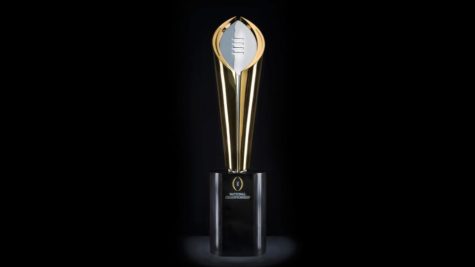The Good, the Bad, and the Ugly About The New College Football Playoff Format
December 2, 2022
On September 2nd, 2022, the college football world was finally given its first official sneak peek into the future. After a year of heavy dispute, The College Football Playoff committee approved a plan to expand the playoff format from a 4-team playoff bracket, to a 12-team bracket. This will go into effect by the 2026 college football season. This decision to expand the playoffs by 8 teams has been heavily disputed by fans on whether or not it is the best idea for the future of college football.
 Pictured above: The coveted College Football Playoff trophy (picture from ESPN)
Pictured above: The coveted College Football Playoff trophy (picture from ESPN)
The current playoff system chooses 4 teams, and that 4 team pool is usually made up of Power 5 conference teams who won their respective conference championships. In NCAA Division I football, there are 10 total conferences, each with around 8 to 12 college teams within them. The Power 5 conferences are made up of the Atlantic Coast Conference (ACC), Big Ten Conference, Big 12 Conference, PAC-12 Conference, and the Southeastern Conference (SEC). These conferences are generally more popular and have more monetary advantages than the other 5 conferences. Along with these Power 5 schools, there are the “Group of 5” conferences, which consist of the American Athletic Conference, Conference USA, Mid-American Conference, Mountain West Conference, and Sun Belt Conference. Out of 32 total teams selected for the Playoff thus far, only 1 of these teams has been a Group of 5 school.
 Pictured above: Alabama taking down Cincinnati (the only Group of 5 school to play in the College Football Playoff) in the 2021 Cotton Bowl Classic (picture from rollbamaroll.com)
Pictured above: Alabama taking down Cincinnati (the only Group of 5 school to play in the College Football Playoff) in the 2021 Cotton Bowl Classic (picture from rollbamaroll.com)
An issue of this 4-team system is that only 4 of these Power 5 conferences will be represented in the College Football Playoff. In some cases, such as the 2018 playoff where SEC colleges, Georgia and Alabama, both participated, a single Power 5 conference is represented by 2 teams, and 2 Power 5 champions are cut out in the process. John Swofford, the former ACC commissioner, stated in 2014, “You have four teams that get a chance to play for the national championship, which is twice as many as before. But whoever’s fifth or sixth is not going to be happy. There will be some [Power 5] conferences that won’t have a team in the playoff.”
In a 2014 poll published by ESPN that surveyed 103 college football coaches, 44% of coaches wanted an 8-team playoff, 29% were fine with the 4-team system, and 17% wanted a 16-team playoff. An 8-team playoff system has many positives to it and seems to be the idea best favored by most college football fans. An 8-team bracket could represent all five Power 5 champions, as well as a Group of 5 champion, and two wild card teams.
Ben Dacklw of Yahoo! Sports believes a 6-team playoff would be another significant option. “Adding in those No. 3 vs. No. 6 and No. 4 vs. No. 5 games could add one more week of great football to the college football season,” Dacklw writes. “Adding those spots to the playoff could also lead to more athletic departments deciding to go all-in on their football programs, leading to more competitive teams.” Dacklw has his own gripes about a 12-team playoff, saying that, historically, college football is “a very top-heavy sport. It always has been, and it always will be. There isn’t going to be a playoff where there’s one Cinderella team every season. It will be a heavily one-sided affair in favor of the higher seeds.”
ClutchPoints writer Enzo Flojo has his own list of cons for the 12-team system. In accordance with an expansion of teams, there would be more overall games at the end of the year. This provides more opportunities for players to get injured. Flojo also believes the expansion of teams in the Playoffs will not decreasethe advantage of the Power 5 schools. Flojo argues, “the nation’s top players often attend Power 5 programs, which generate the strongest teams. The playoffs are intended for those top teams.” To back this up, Flojo shares that, “of the 28 teams picked across the seven years of the College Football Playoff, 20 of those bids have gone to just four schools. These are Alabama, Clemson, Ohio State, and Oklahoma. Alabama, Clemson, and Ohio State are responsible for six CFP National Championships.”
Flojo also goes on to explain that more teams might not make an impact on teams’ chances, as lower seeds would be at a historic disadvantage. “Furthermore, only twice has a four-seed won a game in the CFP,” Flojo states. “That’s Ohio State in the first-ever playoff and Alabama in 2017. Both went on to win national titles. What about the remaining five years? Four seeds have fallen by an average of 20 points and have never led at halftime.” Flojo does not believe expanding the playoff pool will fix the issue of lower seeds being easily beaten.
 Pictured above: A College Football Playoff-themed helmet (picture from Sports Illustrated)
Pictured above: A College Football Playoff-themed helmet (picture from Sports Illustrated)
Of course, with these negatives, there are also glistening positives. Sports Illustrated states that a 12-team playoff “enhances the survival chances for the three diminished Power 5 leagues outside of the SEC and Big Ten—not to mention the downstream Group of 5 leagues. There are six guaranteed spots for the top 6 league champions. That means the champs of the ACC, Big 12 and Pac-12 should make a 12-team Playoff every season, and a second Playoff participant from those leagues is possible as well.” With more conferences being represented, there will be more overall success in college football, as great teams who have proven their ability to win can be snubbed out of the 4-team playoff and are stuck just playing a bowl game without the chance to win the National Championship. This also gives more NFL Draft prospects college games to show off their skills to scouts against high-level competition. Besides the improving Power 5 representation, extra playoff spots allow for the best Group of 5 schools to get their shot at a National Championship as well. There certainly are major positives to an expanded playoff.
By 2026, the college football world will change immensely. The competition and race for 12 playoff spots will begin. Whether or not these changes prove to be bad or great, it will be a major, exciting shift for many college fans.
